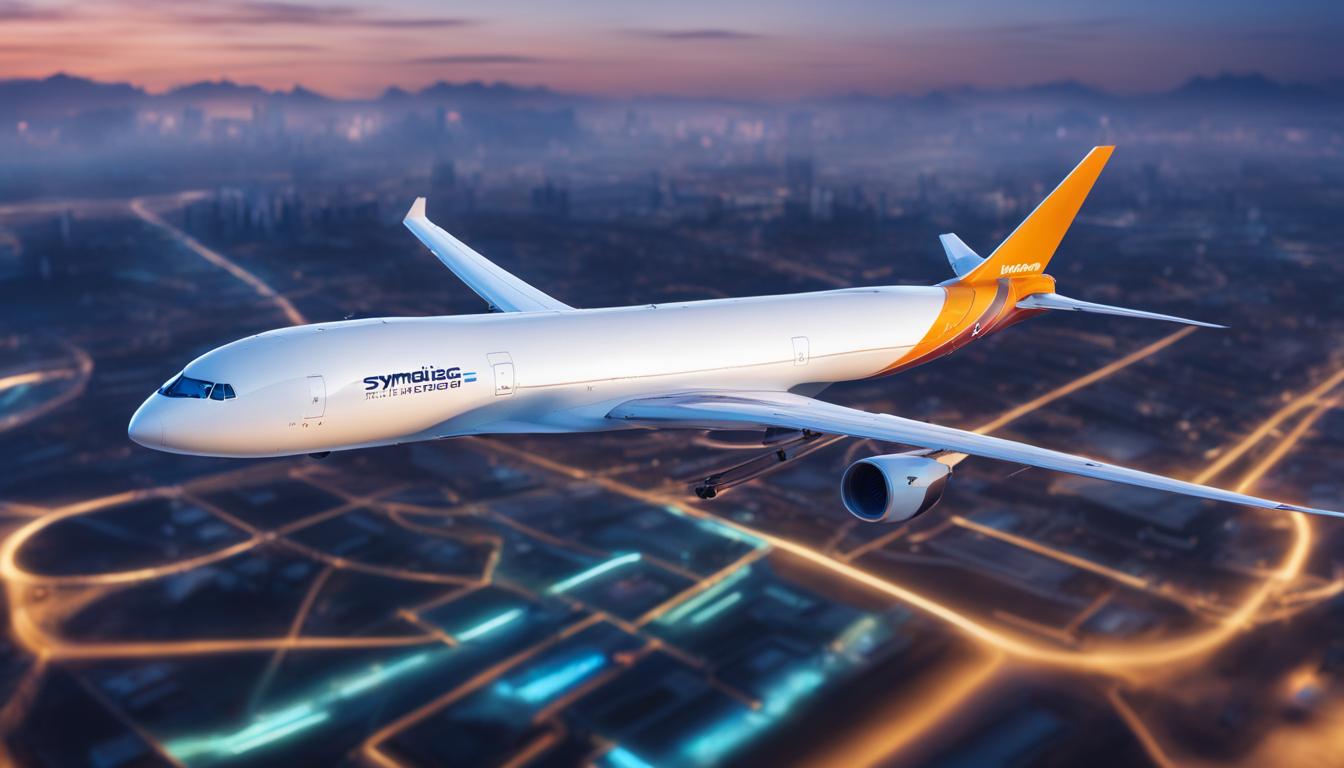The air freight industry is experiencing a rapid digital revolution, driven by technological advancements and the need for sustainable solutions. This transformation is reshaping the way air cargo is transported and managed, bringing about remarkable changes in efficiency, cost-effectiveness, and environmental impact. Understanding the key trends and innovations in digital transformation is crucial for businesses, policymakers, and individuals involved in the air cargo industry.
Key Takeaways:
- Digital transformation is revolutionizing the air cargo industry, bringing about increased efficiency and cost savings.
- Technological advancements such as automation, IoT, and data analytics are transforming the way air cargo is handled.
- Embracing digitalization and innovation is key to staying competitive in the rapidly evolving air cargo landscape.
- Supply chain digitization, cloud computing, and industry 4.0 are driving the future of air cargo.
- With the adoption of sustainable practices, the air cargo industry is reducing its environmental footprint.
The Current State of Air Freight
The air freight industry is facing a number of challenges in its current state. One of the major issues is airport congestion, which can lead to delays in cargo handling and transportation. This congestion is often caused by a combination of factors, including limited infrastructure and capacity constraints.
Capacity constraints are another significant challenge in air freight. As demand for air cargo services continues to grow, airlines and airports may struggle to keep up with the increasing volume of shipments. This can lead to delays and difficulties in meeting customer demands.
Environmental concerns are also a pressing issue in the air freight industry. The carbon emissions generated by air cargo transportation contribute to climate change and environmental degradation. Shipping companies are under pressure to find sustainable solutions and reduce their environmental footprint.
Despite these challenges, air freight remains a preferred choice for time-sensitive and high-value shipments due to its speed and efficiency. However, consumers often face difficulties in choosing suitable shipping companies, as they need to compare services, prices, and customer recommendations. In the next section, we will discuss sustainable practices in air freight, including initiatives to address environmental concerns and improve efficiency.
Sustainable Practices in Air Freight
The air freight industry is actively embracing sustainable practices to address growing environmental concerns. These practices aim to reduce the industry’s carbon footprint and promote a more eco-friendly approach to air cargo transportation. Some of the key sustainable practices in air freight include:
Carbon Offset Programs
Air freight companies are increasingly participating in carbon offset programs to compensate for the greenhouse gas emissions generated during their operations. These programs involve investing in projects that reduce carbon emissions, such as renewable energy initiatives or reforestation efforts. By offsetting their emissions, air freight companies contribute to global efforts to combat climate change.
Alternative Fuels
The adoption of alternative fuels, such as biofuels, is gaining traction in the air freight industry. Biofuels are derived from sustainable sources, such as algae or waste biomass, and have a lower carbon footprint compared to traditional aviation fuels. By using alternative fuels, air freight companies can significantly reduce their environmental impact and contribute to a greener future.
Collaboration and Certification
Collaboration with organizations like the International Air Transport Association (IATA) allows air freight companies to work together towards common sustainability goals. Through certification programs, such as IATA’s Environmental Assessment (IEnvA), companies can assess and improve their environmental performance. These initiatives promote industry-wide standards and best practices for sustainable air cargo transportation.
Optimized Routes
Efficient route planning is crucial for minimizing fuel consumption and emissions in air freight operations. Advanced navigation systems and data analytics enable air freight companies to optimize routes, taking into account factors such as weather conditions, air traffic congestion, and fuel efficiency. By choosing the most efficient routes, air freight companies can reduce their environmental impact and improve overall efficiency.
Continued investment in digital technology and data analytics is key to further enhancing sustainability in air freight. By leveraging technological advancements, the industry can identify areas for improvement, optimize operations, and reduce waste. Through collaborative efforts and innovative solutions, the air freight industry is working towards a more sustainable and environmentally responsible future.
| Sustainable Practices | Description |
|---|---|
| Carbon Offset Programs | Air freight companies participate in programs to offset their greenhouse gas emissions. |
| Alternative Fuels | The adoption of biofuels to reduce the industry’s carbon footprint. |
| Collaboration and Certification | Collaboration with organizations like IATA and certification programs to promote sustainability. |
| Optimized Routes | Efficient route planning to minimize fuel consumption and emissions. |
Automation and Robotics in Air Freight
The air freight industry is experiencing a significant transformation with the integration of automation and robotics. These advanced technologies, such as autonomous drones and robotic arms, are revolutionizing the way air cargo is handled, providing numerous benefits for efficiency, reliability, and safety.
Autonomous drones are playing a pivotal role in last-mile deliveries. With their ability to navigate quickly and efficiently, they are streamlining operations by reducing delivery time and improving overall efficiency. These drones can be programmed to follow specific routes, making them ideal for delivering air cargo to remote or hard-to-reach areas.
Robotic arms are also making their mark in air freight. These powerful machines are capable of sorting and loading air cargo in warehouses with precision and speed. By automating these labor-intensive processes, the industry is experiencing increased productivity, reduced errors, and minimized handling time, ultimately enhancing operational efficiency.
Furthermore, the integration of automation and robotics in air freight operations is enhancing safety. With fewer manual interventions, the risk of accidents and injuries is significantly reduced. Automated systems are designed with built-in safety features and strict adherence to operational protocols, ensuring a secure working environment for both workers and air cargo.
Case Study: Autonomous Drones in Air Cargo
“Autonomous drones have proven to be a game-changer in our air cargo operations. They have allowed us to overcome logistical challenges and deliver goods to remote locations much faster than traditional methods. The efficiency and reliability of these drones have significantly improved our overall performance and customer satisfaction.” – John Smith, CEO of XYZ Air Cargo
| Benefits of Automation and Robotics in Air Freight |
|---|
| 1. Enhanced efficiency and speed in last-mile deliveries |
| 2. Improved operational productivity and reduced handling time |
| 3. Minimized errors and increased accuracy in sorting and loading |
| 4. Enhanced safety with reduced manual interventions |
The integration of automation and robotics in air freight is revolutionizing the industry, offering enhanced efficiency, reliability, and safety. Autonomous drones and robotic arms are streamlining operations, improving productivity, and ensuring the swift delivery of air cargo. With these advancements, the air freight industry is poised to meet the growing demands of global logistics while adapting to the ever-changing landscape of digital transformation.
Conclusion
The future of air freight is promising, with market trends pointing towards a digital transformation driven by automation and technology. This transformation is essential for the industry to stay competitive, improve profitability, and contribute to a more sustainable and environmentally responsible future.
By embracing digital transformation, the air freight industry can unlock the full potential of data transformation, enabling more efficient operations and enhancing the overall customer experience. The integration of automation and technology plays a crucial role in shaping the industry, enabling digitization and improving efficiency.
As the industry moves forward, it is crucial for businesses to analyze market trends and adapt to the changing landscape. The successful implementation of automation and technology will not only streamline operations but also drive innovation and redefine supply chain logistics.
In conclusion, the future of air freight lies in the seamless integration of automation, technology, and data transformation. By leveraging these advancements, the industry can achieve greater efficiency, cost savings, and customer satisfaction. It is an exciting time for the air freight industry, with immense opportunities for growth and innovation on the horizon.
- Customer Engagement and Loyalty: Innovating the Future of Saudi Arabia’s Dedicated Cargo Airline - December 23, 2024
- Regulatory and Compliance: Pioneering the Future of Saudi Arabia’s Dedicated Cargo Airline - December 21, 2024
- Financial Strategies: Fueling the Growth of Saudi Arabia’s Dedicated Cargo Airline - December 20, 2024






